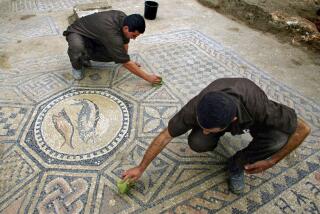Digging for Knowledge in Israel : Volunteers are welcome to explore Beth Shean site year-round.
- Share via
BETH SHEAN, Israel — With the hot sun beating on the back of my neck, I knelt forward and gently brushed away the earth, half-burying the ancient object in front of me.
I don’t know what I expected to find when I joined up as a volunteer on this archeological dig--coins, jewelry, perhaps even some painted pottery. What I wasn’t quite prepared for was the two rows of teeth attached to the jaw of a large creature that seemed to be staring right back at me.
I had spent the morning with two volunteers--Debbie, 24, from Sydney, Australia, and Jil, 20, from Berlin--who were contributing their time and energy to help explore the site of the largest archeological excavation in Israel, at Beth Shean.
As I gazed across the site’s major streets, which were flanked by tumbled columns, Byzantine baths and a Roman amphitheater with seating for 5,000, project leader Gaby Mazor from the Israel Antiquities Authority pointed out that only about 5% of the city has actually been excavated so far.
There have been settlements in the Beth Shean area, once an important military and trading center, since 5,000 BC. It was first mentioned in Egyptian writings in 19th-Century BC. In the 11th-Century BC, the bodies of Saul and his sons were displayed on the walls of the city after their defeat on nearby Mt. Gilboa.
The city peaked in population at 40,000 in the AD 6th Century, and then was conquered by Muslims in the mid-7th Century. At 10 a.m. on June 18 in AD 749 (the precise time and date has been pinpointed through surviving documents), the city was destroyed by an earthquake. The buildings and artifacts that the archeologists are uncovering today shows evidence of the damage.
The excavation project was started to create work for people in the area. Already it has become a major attraction for tourists, yet as they wander through for a look, the work continues. About 200 are employed digging and surveying on the site, and throughout the year another 200 contribute a minimum of two weeks working as amateur archeologists.
Archeologists in Israel enlist inexperienced volunteers because they have found that most are highly motivated and interested in learning. To be a volunteer you must be in good physical shape; you’ll be digging, shoveling and hauling baskets of earth in hot weather. Most volunteers are needed between May and September, when universities are not in session. The Beth Shean project is open year-round.
Accommodations for volunteers can range from sleeping bags in a field to hostels and hotels. On this dig, some of the volunteers were staying in free accommodations provided by the project, while supplying their own meals. They described their lodgings guardedly as “interesting.” Others had arranged through the project to stay at a nearby kibbutz for $20 per day, which included three meals and use of the swimming pool. They seemed much happier.
Those interested in volunteering for this dig can contact the Beth Shean Project, P.O. Box 381, 10900 Beth Shean, Israel. In Israel, telephone (06) 585-367.
A list of archeological excavations that accept volunteers is prepared by the Israel Antiquities Authority, P.O. Box 586, Jerusalem 91004, Israel, local telephone (02) 292-607.
If you just want to try working at a site in Israel for a day, and you have a group of at least four people, you can make arrangements through Heritage Excavations, 19 Hagana St., New Industrial Zone, Rishon le-Zion 75706, Israel. The price is $20 per person.
During July and August, independent travelers can join “Dig for a Day” programs through Archaeological Seminar Ltd. at 11 Shonei Halachot, Jewish Quarter, P.O. Box 14002, Jaffa Gate, Jerusalem, Israel 91400, local phone (02) 273 515. The cost is $17, not including food and transportation.
For more information on travel to Israel, contact the Israel Government Tourist Office, 6380 Wilshire Blvd., Suite 1700, Los Angeles 90048, (213) 658-7462.
More to Read
Sign up for Essential California
The most important California stories and recommendations in your inbox every morning.
You may occasionally receive promotional content from the Los Angeles Times.













